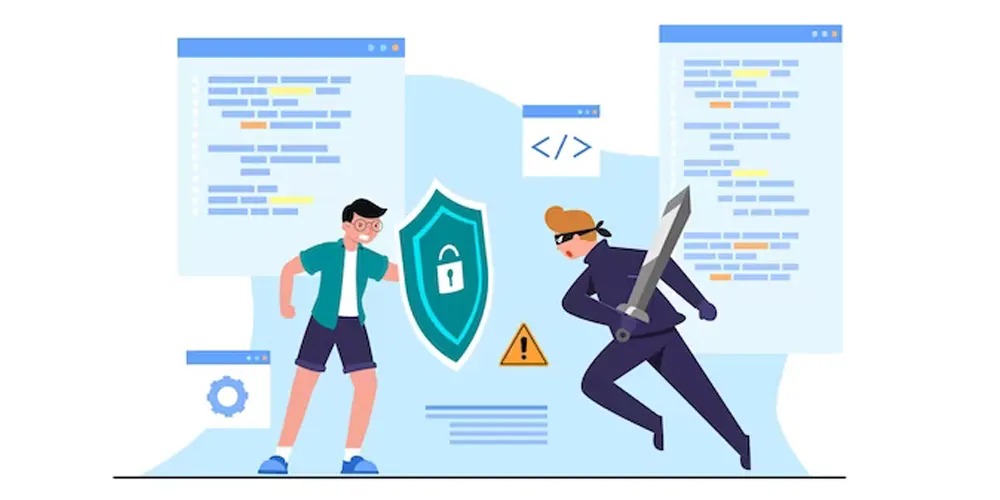9 Key Functions of an SBC Explained
Ever wonder how your voice and video calls manage to travel effortlessly through the internet? How you can connect with friends, family, or colleagues across the globe? You have Session Border Controllers (SBCs) to thank for.
Think of SBCs as the traffic cops of telecommunication, directing the flow of VoIP and multimedia communication. They're the reason your calls are clear, secure, and reach their destination without a hitch.
We'll dive into the fascinating world of SBCs, exploring their roles in enhancing security, ensuring quality, and making sure your calls follow the rules.
Doesn’t matter if you’re new to the world of telecommunication or a veteran VoIP Carrier. There is always something to learn when it comes to technology.
So join me as we uncover the key functions of SBCs that keep our digital conversations flowing smoothly in today's interconnected world!
1. Security Enforcement

The security enforcement feature of a Session Border Controller (SBC) is a critical aspect that safeguards VoIP networks from various threats.
Acting as a digital sentry, the SBC serves as a protective gateway. It prevents unauthorized access and secures the integrity of voice and data traffic.
It employs several security mechanisms to ensure that only legitimate communication requests are allowed. This includes firewall protection to filter incoming and outgoing traffic
Additionally, SBCs provide encryption capabilities. They shield sensitive information from eavesdroppers during transmission. Access control mechanisms are in place to verify the identities of users and devices, thwarting potential cyberattacks.
This comprehensive security suite helps maintain the confidentiality, availability, and authenticity of VoIP communication. Thus making SBCs a vital component in safeguarding network assets and ensuring regulatory compliance.
In essence, the security enforcement feature of an SBC acts as a robust barrier against cyber threats. It fortifies the VoIP infrastructure and enhances the overall network security posture.
2. Interoperability and Protocol Translation

The Interoperability and Protocol Translation function of a SBC represents a pivotal and technically sophisticated feature within VoIP networks.
In the landscape of VoIP communication, various signaling protocols, codecs, and standards exist. Each is tailored to specific network and device requirements. These disparities often pose challenges when different VoIP entities need to interconnect.
SBCs serve as adept protocol mediators and translators, strategically positioned at the network border. When two VoIP entities with distinct signaling protocols attempt to establish a call, the SBC steps in as the linguistic bridge.
It proficiently interprets, translates, and reconfigures signaling messages. Thus ensuring that the communicating parties can understand and effectively interact with one another.
This encompassing task involves address mapping, call setup request conversion, and the management of session initiation and termination procedures.
Furthermore, SBCs demonstrate excellence in codec transcoding. It's a process in which they convert audio codecs utilized for voice compression and decompression.
This critical function guarantees that, regardless of the codecs in use by the calling parties, the SBC can expertly translate and adapt the voice signals.
Consequently, this ensures compatibility and maintains consistent voice quality throughout the communication session.
3. Quality of Service (QoS) Management

The QoS Management function of a Session Border Controller plays a pivotal role in ensuring the smooth and high-quality operation of VoIP communication. It is responsible for optimizing the network's performance.
The optimizations guarantee that voice and multimedia traffic, which are highly sensitive to delays and disruptions, receive the highest priority in transmission.
SBCs accomplish this by meticulously monitoring network traffic and categorizing data packets based on their importance. VoIP packets are identified and prioritized over other non-real-time data, such as file downloads or email traffic.
This prioritization minimizes latency, ensuring that voice calls remain clear and free from noticeable delays. The SBC can also regulate and allocate bandwidth dynamically, adjusting resources in real time to meet the demands of VoIP traffic.
This means that during periods of high activity, such as conference calls or video chats, the SBC can allocate more bandwidth to ensure a seamless user experience.
Additionally, SBCs offer traffic-shaping capabilities, enabling administrators to define policies that control the flow of traffic. This allows them to allocate specific bandwidth levels to different types of VoIP traffic to ensure optimal performance.
4. Session Control and Management

In terms of Session Control and Management, a Session Border Controller acts as the orchestrator of VoIP sessions. It oversees the establishment, management, and termination of these sessions to ensure they operate efficiently and securely.
1. Call Setup - When a VoIP call is initiated, the SBC plays a central role in setting up the connection. It manages the signaling process, which includes tasks like call routing, address translation, and protocol negotiation. This ensures that the call request reaches the intended destination correctly.
2. Session Monitoring - During a VoIP call, the SBC continuously monitors the session to ensure its quality and security. It keeps tabs on parameters like packet loss, jitter, and latency, making real-time adjustments to maintain a high-quality conversation.
3. Security Enforcement - The SBC enforces security policies throughout the session, protecting against potential threats and unauthorized access. It guards against cyberattacks and ensures compliance with encryption standards, safeguarding the confidentiality of the communication.
4. Session Termination - Once the call is completed, the SBC ensures proper session termination. It releases network resources, closes connections, and manages session cleanup to free up network capacity for other communication sessions.
Thus, an SBC does more than just provide security. It also orchestrates traffic to ensure every call is delivered seamlessly.
5. Network Topology Hiding

If no one can see you, no one can pose a threat to you! That’s one thing we learned in the first Harry Potter movie. An SBC works similarly to the invisibility cloak, it hides your network topology and internal architecture from all external parties.
Without visibility over your VoIP network, bad actors will not have an easy time spotting and exploiting vulnerabilities therein.
Here's how it works:
1. Obfuscation - The SBC obfuscates the internal IP addresses and network structure of the VoIP network. It does this by replacing internal network addresses with its own address in signaling messages and data packets.
As a result, external entities, including potential attackers, only see the SBC's address and have no knowledge of the network's actual layout.
2. Protection - By hiding the network topology, the SBC adds an additional layer of security. Attackers attempting to map out the network or exploit vulnerabilities are thus thwarted.
The inability to discern the actual devices and resources within the network proves a significant hindrance in their quest for malice.
3. Privacy - This function enhances user privacy by preventing the exposure of internal IP addresses. It adds a level of anonymity to VoIP communication, making it more challenging for malicious entities to track or target specific endpoints.
So if you always wanted an invisibility cloak, an SBC is your best option, for VoIP networking at least!
6. Distributed Denial of Service (DDoS) Mitigation

DDoS attacks are the bane of the wider internet. The usual targets of these attacks have naturally been industries and businesses that are highly sensitive to downtime and service disruptions.
DDoS attacks involve overwhelming a network with a flood of traffic from multiple compromised sources, rendering it inaccessible to legitimate users. Thankfully, SBCs are smart and capable enough to deal with DDoS attacks.
Here's how it works.
1. Traffic Analysis - The SBC continuously monitors incoming network traffic, scrutinizing it for patterns consistent with a DDoS attack. It analyzes factors such as traffic volume, source IP addresses, and request rates.
2. Attack Identification - When a DDoS attack is detected, the SBC quickly identifies the malicious traffic sources and patterns causing the disruption. This precise identification is crucial for an effective response.
3. Traffic Filtering - The SBC employs traffic filtering mechanisms to separate legitimate traffic from malicious traffic. It can divert or block malicious traffic while allowing legitimate communication to continue unaffected.
4. Rate Limiting - To prevent the network from becoming overwhelmed, the SBC can implement rate-limiting policies. This restricts the volume of incoming requests, ensuring that resources are allocated appropriately.
5. Anomaly Detection - SBCs may use anomaly detection algorithms to identify deviations from normal traffic behavior. Unusual traffic patterns can trigger alerts and proactive mitigation actions.
All in all, an SBC will also effectively protect you from the bad actors on the internet trying to cause problems for your business.
7. Policy Enforcement

The scope of policy enforcement is quite wide. You may have some internal policy regarding routing or profits that you may want to enforce to achieve specific outcomes.
Additionally, some regulatory requirements may also require you to set up and implement specific routing policies for compliance. Then there are also provider and region-specific requirements that can be fulfilled through routing policies.
Here's how it works.
1. Access Control - SBCs enforce access policies that determine who can connect to the VoIP network. This includes authenticating users and devices, and ensuring that only authorized entities gain access.
2. Security Policies - SBCs implement security policies to protect against threats like cyberattacks and unauthorized access. They enforce encryption standards, firewall rules, and intrusion detection to maintain network security.
3. Call Routing and Quality Policies - SBCs can define call routing policies, ensuring that calls are directed according to business rules. These rules may include parameters such as cost, load balancing or Quality of Service (QoS).
4. Regulatory Compliance - SBCs help organizations adhere to legal and regulatory requirements. For example, they support call recording and lawful intercept capabilities, ensuring compliance with government regulations.
5. Emergency Services - SBCs can enforce policies related to emergency services. They can ensure that all calls to emergency numbers are appropriately routed and handled.
Thus, policy enforcement allows for additional and more granular rule-based traffic routing. Multiple objectives can be achieved resulting in more seamless and secure routing of calls throughout the network.
8. Redundancy and Failover

High availability and uninterrupted flow of calls is a primary requirement when it comes to VoIP Communication. Ensuring these two requirements is crucial as the communication industry is very sensitive to downtime.
Session Border Controllers come baked in with safeguards against service disruptions. They are designed to work around network issues and hardware failure, any of which could end up disrupting the communication services.
Here's how it works.
1. Redundant Hardware - SBCs are often deployed in pairs or clusters with redundant hardware. If one SBC encounters a hardware failure, the backup takes over seamlessly. This redundancy ensures continuity of service even in the face of hardware faults.
2. Session State Preservation - During failover, the SBC ensures that ongoing VoIP sessions remain active and undisturbed. This means that ongoing calls are not dropped, and new sessions can be established on the backup SBC.
3. Load Balancing - SBCs can balance the network load across multiple servers or instances. In the event of increased traffic or resource demand, this load balancing ensures that there are no bottlenecks and that resources are efficiently utilized.
4. Health Monitoring - The SBC constantly monitors the health and status of its components and network connections. When it detects a potential issue or failure, it can initiate a failover to the backup system before the issue affects service quality.
5. Automatic Failover Routing - In the event of a failure, the SBC can automatically reroute traffic to available resources or backup data centers, ensuring service continuity.
In essence, SBCs help deliver an uninterrupted and highly available communication service to customers. By minimizing disruptions and capably handling unforeseen technical conditions, SBCs ensure an uninterrupted flow of calls.
9. Regulatory Compliance

The telecommunication industry is subject to a diverse set of regulations all around the world. The regulatory compliance requirement depends upon the region you operate in.
As discussed earlier, the policy enforcement function in SBCs can be used to enforce routing policies and rules to comply with certain region-specific regulations.
Here's how it works.
1. Call Recording - SBCs can facilitate call recording to comply with regulatory requirements. This is particularly important in industries like finance and healthcare, where call records must be maintained for compliance and auditing purposes.
2. Emergency Services Support - SBCs enforce policies related to emergency services. This will ensure that calls to emergency numbers (e.g., 911) are routed to the appropriate authorities, and location information is transmitted accurately.
3. Lawful Intercept Capabilities - From time to time, legal authorities require interception of communication for investigative purposes. SBCs can provide the necessary capabilities to intercept and monitor calls lawfully.
4. Privacy Protection - SBCs can also enforce privacy policies. They can ensure that user data and communication remain confidential and in compliance with data protection regulations.
5. Regulatory Reporting - SBCs often generate reports and logs that demonstrate compliance with regulatory requirements. These reports can be valuable during audits or investigations.
Thus, SBCs make complying with various regulatory requirements around the world easy. Additional industry-wise regulatory requirements can be fulfilled similarly using SBCs.
With that, we’ve covered every key function of a Session Border controller. Let’s wrap things up!
Conclusion
I won’t be surprised if most of you thought SBCs only acted as Gateways at the start of this article. There is always more than meets the eye when it comes to technology.
All of the key functions mentioned above are distinct from one another. These can be grouped together under the umbrella of security and traffic management. However, each function covers a different operational area.
I hope this article has helped you understand the role and functions of a Session border controller in depth. Stay tuned as we have more articles about SBCs coming up!
























































































































